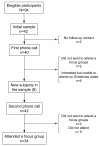How do care-provider and home exercise program characteristics affect patient adherence in chronic neck and back pain: a qualitative study
- PMID: 20219095
- PMCID: PMC2847560
- DOI: 10.1186/1472-6963-10-60
How do care-provider and home exercise program characteristics affect patient adherence in chronic neck and back pain: a qualitative study
Abstract
Background: The aim of this study is to explore perceptions of people with chronic neck or low back pain about how characteristics of home exercise programs and care-provider style during clinical encounters may affect adherence to exercises.
Methods: This is a qualitative study consisting of seven focus groups, with a total of 34 participants presenting chronic neck or low back pain. The subjects were included if they were receiving physiotherapy treatment and were prescribed home-based exercises.
Results: Two themes emerged: home-based exercise programme conditions and care provider's style. In the first theme, the participants described their positive and negative experiences regarding time consumption, complexity and effects of prescribed exercises. In the second theme, participants perceived more bonding to prescribed exercises when their care provider presented knowledge about the disease, promoted feedback and motivation during exercise instruction, gave them reminders to exercise, or monitored their results and adherence to exercises.
Conclusions: Our experiential findings indicate that patient's adherence to home-based exercise is more likely to happen when care providers' style and the content of exercise programme are positively experienced. These findings provide additional information to health care providers, by showing which issues should be considered when delivering health care to patients presenting chronic neck or back pain.
Figures
Similar articles
-
Parents of children with physical disabilities perceive that characteristics of home exercise programs and physiotherapists' teaching styles influence adherence: a qualitative study.J Physiother. 2015 Apr;61(2):81-6. doi: 10.1016/j.jphys.2015.02.014. Epub 2015 Mar 21. J Physiother. 2015. PMID: 25804826
-
Barriers to home-based exercise program adherence with chronic low back pain: Patient expectations regarding new technologies.Ann Phys Rehabil Med. 2016 Apr;59(2):107-13. doi: 10.1016/j.rehab.2016.01.009. Epub 2016 Apr 1. Ann Phys Rehabil Med. 2016. PMID: 27050664
-
Personal characteristics influencing patients' adherence to home exercise during chronic pain: a qualitative study.J Rehabil Med. 2009 Apr;41(5):347-52. doi: 10.2340/16501977-0338. J Rehabil Med. 2009. PMID: 19363568
-
The role of physiotherapy in the management of non-specific back pain and neck pain.Rheumatology (Oxford). 2006 Apr;45(4):371-8. doi: 10.1093/rheumatology/kei242. Epub 2005 Dec 6. Rheumatology (Oxford). 2006. PMID: 16332949 Review.
-
Defining adherence to therapeutic exercise for musculoskeletal pain: a systematic review.Br J Sports Med. 2020 Mar;54(6):326-331. doi: 10.1136/bjsports-2017-098742. Epub 2018 Jun 6. Br J Sports Med. 2020. PMID: 29875278
Cited by
-
Individuals with chronic low back pain have greater difficulty in engaging in positive lifestyle behaviours than those without back pain: an assessment of health literacy.BMC Musculoskelet Disord. 2011 Jul 15;12:161. doi: 10.1186/1471-2474-12-161. BMC Musculoskelet Disord. 2011. PMID: 21756363 Free PMC article.
-
Use of outcome measures in managing neck pain: an international multidisciplinary survey.Open Orthop J. 2013 Sep 20;7:506-20. doi: 10.2174/1874325001307010506. eCollection 2013. Open Orthop J. 2013. PMID: 24115972 Free PMC article.
-
Consensus for physiotherapy for shoulder pain.Int Orthop. 2015 Apr;39(4):715-20. doi: 10.1007/s00264-014-2639-9. Epub 2014 Dec 31. Int Orthop. 2015. PMID: 25548127
-
Evaluation of pain and function after two home exercise programs in a clinical trial on women with chronic neck pain - with special emphasises on completers and responders.BMC Musculoskelet Disord. 2014 Jan 8;15:6. doi: 10.1186/1471-2474-15-6. BMC Musculoskelet Disord. 2014. PMID: 24400934 Free PMC article. Clinical Trial.
-
Therapist competencies in the context of group-based exercise programs in medical rehabilitation: a qualitative study with patients and exercise therapists from Germany.BMC Sports Sci Med Rehabil. 2023 Apr 21;15(1):64. doi: 10.1186/s13102-023-00674-8. BMC Sports Sci Med Rehabil. 2023. PMID: 37085945 Free PMC article.
References
-
- Swedish Council on Technology Assessment in Health Care (SBU) Back pain and neck pain: an evidence based review. Stockholm:SBU; 2000.
Publication types
MeSH terms
LinkOut - more resources
Full Text Sources
Medical



